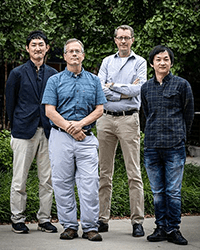World’s First Three-Organoid System Opens Doors for Medical Research and Diagnosis
|
Top Breakthrough Discovery | Published September 2019 in Nature |

Kentaro Iwasawa, MD, Jim Wells, PhD, Aaron Zorn, PhD, and Takanori Takebe, MD, PhD
More than five years of painstaking research went into the project, and yet, its success came almost by accident.
Many in the field of regenerative medicine took note when a team of scientists led by first author Hiroyuki Koike, PhD, and senior author Takanori Takebe, MD, PhD, revealed in the journal Nature that they successfully produced a connected set of three organoids: the liver, pancreas and biliary ducts.
Organoids, grown from stem cells, are tiny 3D formations of human tissue that contain multiple cell types and can perform the functions of full-sized organs. Organoid experts at Cincinnati Children’s led by Jim Wells, PhD, have already grown intestines that feature nutrient-absorbing villi, stomach organoids that produce digestive acids, and others.
By themselves, human organoids already provide a sophisticated tool for research. But this advance allows scientists to study how human tissues work in concert. Eventually, organoid systems could begin reducing the need for animal-based medication studies, sharply accelerate the concept of precision medicine, and someday lead to transplantable tissues grown in labs.
“The connectivity is the most important part of this,” Takebe says. “What we have done is design a method for producing pre-organ, formation-stage tissues so that they can develop naturally. We are maximizing our capacity to make multiple organs much like our body does.”
“Connecting the organs is a crucial unmet challenge to move organoid therapy into reality.”
A 5-Year Question Achieves Key Goal
Takebe, age 32, joined Cincinnati Children’s in 2016 and holds a dual appointment at Tokyo Medical and Dental University (TMDU) in Japan. He graduated from medical school in 2011 with plans to become a liver transplant surgeon. But as he learned about the yawning gap between the supply and demand for donor organs, Takebe shifted gears to focus on organ supply.
In previous research, Takebe has demonstrated a method to produce large supplies of liver “buds,” an early-stage form of a liver organoid. He also has grown liver organoids that reflect disease states, including steatohepatitis.
But Takebe says this project goes beyond his previous work.
“We noted this point in organ differentiation some time ago. But it took five years to tune up the culture system to allow this development to occur,” Takebe says.





